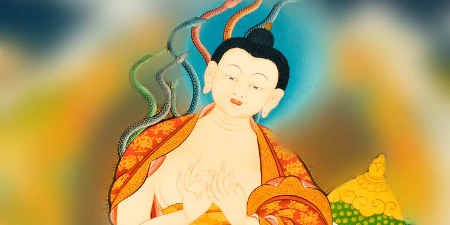Transcending Movement and Stillness – The Life of Bodhidharma
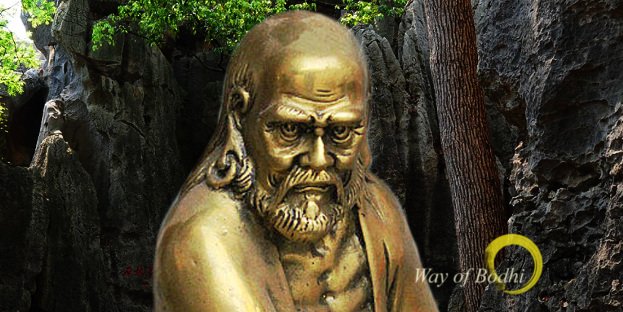
This first part of the trilogy on Bodhidharma narrates the life story of Bodhidharma. As various incidents unfolded during Bodhidharma’s travels in China, they also gave rise to various paradoxical expressions that generations of disciples reflected upon to gain insight into reality.
View other parts of this Trilogy at
Part II – Breaking the Silence – The Teachings of Bodhidharma |
Part III – The Wild Leaps of Awakening – Bodhidharma and Martial Arts |
Contents
Around 5th-6th Century AD in China, the Emperor Wu was getting ready to meet the great Indian Buddhist master Bodhidharma. The Master had already arrived in China and the stories of various encounters people had with him were spreading like the wind. In fact, even before that, carrier pigeons sent by the Pallava king of South India had also reached there announcing the imminent arrival of the Master. So people in anticipation flocked to the Monastery where Bodhidharma was invited to give a teaching. Most of them were quite perplexed to see the Master’s style of teaching. It did not fit into anything that they know so far. This news promptly reached the Emperor, filling his mind with eagerness to meet the Master.
The Hollow Merit of the Pious Emperor
This Emperor was an avid practitioner of Mahayana Buddhism. He supported the monastic Sangha generously, built many Temples and Stupas, promoted vegetarianism and banned the sacrifice of animals and capital punishment. Due to his ardent support for the Buddhist causes he came to be known as the ‘Bodhisattva Emperor’.
Upon meeting Bodhidharma, the Emperor recounted his own great deeds and asked, “Having done all these, how much merit do I have?”. Bodhidharma replied, “None”.
The pious Emperor was least expecting such an answer and was taken aback. He further asked,“What is the first principle of the holy teachings?” Bodhidharma replied: “Vast emptiness, nothing holy”.
Bewildered, the Emperor continued, “Who is standing before me then?”. Bodhidharma said, “I don’t know”.
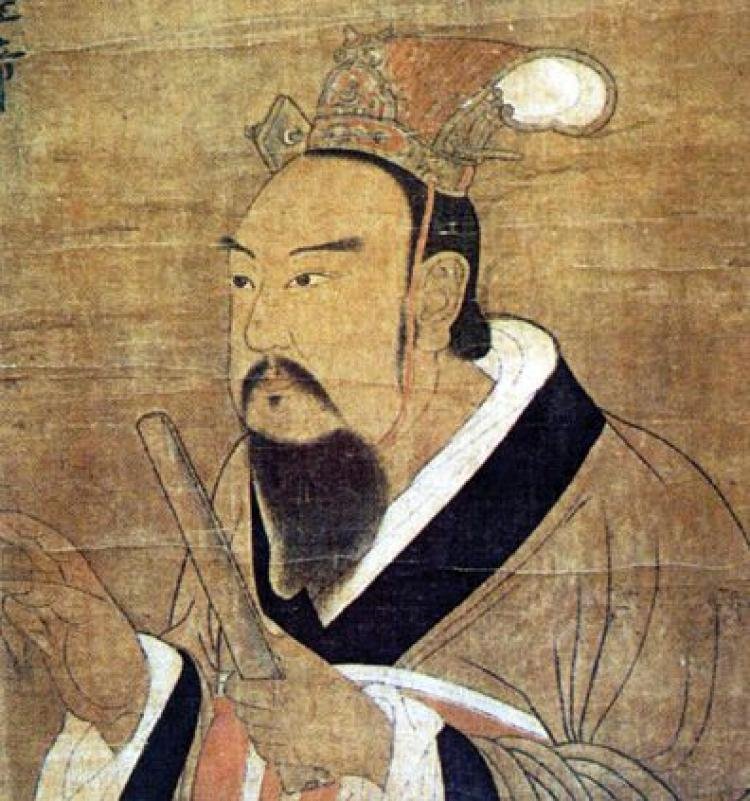
This conversation became famous as one of the first recorded Koans (an often paradoxical anecdote or riddle, that is used to provoke the disciple into deep introspection and to break down his/her frames of reference) in Chan/Zen Buddhism. Here, Bodhidharma was trying to cut across the Emperor’s clinging to ‘spiritual materialism’ and introduce him to the uncompounded nature of reality. The Emperor was sincerely trying to practice Buddhism as he knew it. Yet he was doing all that with the sense of ‘Iam’, the very root of delusion that every practice of Buddhism is supposed to overcome. Though he was performing many virtuous acts, it was just going towards reinforcing his sense of ‘I am’, entangling him further and further in Samsara. With all those generous acts done with a sense of ‘I”, at best, he could gain a ‘nicer’ Samsara, but could not move even an iota closer to Nirvana (liberation).
For the second question of the Emperor, the Master’s response points out that there is nothing to cling on to as holy. And that is what makes everything holy. This is because clinging is at the very root of unholiness.
The response to the third question was supposed to shatter the very clinging to ‘I am’. Indeed there is nothing to know and cling on to as “I am”. Of course, Bodhidharma knows very well that he is a Buddhist master who travelled from India, who is now in China, meeting the Emperor and so on. Yet his form and thoughts are coming and going like water in a river. Nothing stays as the true Bodhidharma. In all that comes and goes there is nothing to point and say, “This is Bodhidharma”.
The Emperor was a truly virtuous person, but he needed to let go of his clinging to ‘I am’. Anyway, the Emperor didn’t get that message and the Master moved on with his journey to the north of China. It is said that later the Emperor realized the greatness of Bodhidharma.Later, upon hearing about the Master’s death, he made the following inscription in tribute to the Master,
Alas! I saw him without seeing him;
I met him without meeting him;
I encountered him without encountering him;
Now as before I regret this deeply!
Who was Bodhidharma ?

Bodhidharma (known as Damo/Pútídámó in China and Daruma /Bodaidaruma in Japan) is well known throughout East Asia and in modern times in the West as the founding master of Chan/Zen Buddhism (dhyāna in Sanskrit). But here in India, his homeland, people hardly know anything about him other than as an esoteric figure who went to China. They especially think of him as a Buddhist monk from South India with mastery in medicine and martial arts. Maybe they learnt this much from the Indians who went on to learn Kungfu and Karate. But in general, people in India are not aware about his background, his realization, his relevance or about his contributions in China. So let us look into Bodhidharma’s life story and teachings as well as the rich wisdom heritage of South India that led to the molding of this great master.
South India during Bodhidharma’s time
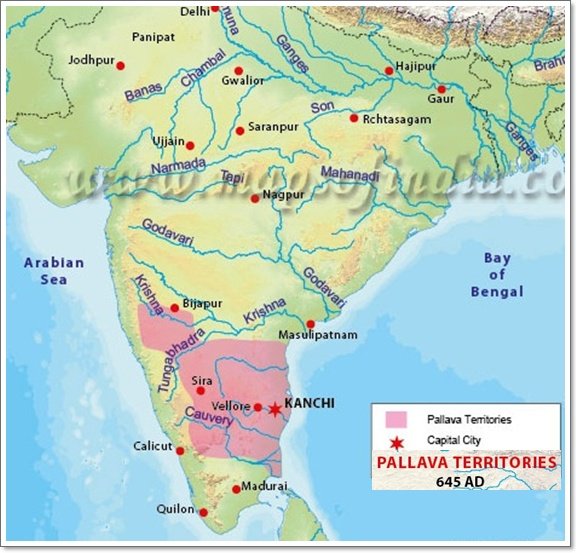
South India was a cradle of Mahayana Buddhism where it thrived for many centuries. The progenitor of Mahayana as a movement, the great Acharya Nagarjuna himself was from the South and so were many of the other great Panditas and Siddhas of Mahayana. Kanchi and Vanchi were renowned Buddhist centers of learning in the South for many centuries (though not well organized in the lines of major Buddhist universities of the North such as Nalanda and Vikramasila). Further, the neighboring forests of Sriparvata and Potalaka were the abodes of choice for many Buddhist Mahasiddhas and Yogis. It was into this milieu that Bodhidharma was born as the third son of the Pallava King Simhavarman II. The prince was then known as Bodhyottara (pronounced as Bodhitara in Chinese sources).
The Pallava kingdom (275 CE to 897 CE) spanned across areas corresponding to the present day Tamil Nadu, Karnataka and Andhra/Telangana. Their capital was at Kanchi (present day Kanchipuram). Kanchi was the birth place of many eminent Buddhist masters. The Theravada commentator Buddhaghosha (5th century CE) and the Buddhist logician Dignaga (5th/ 6th century CE) were from Kanchi. Xuanzang (Hsüan tsang), the Chinese monk traveler who visited India roughly 100 years after Bodhidharma recorded hundreds of Mahayana monasteries and 10,000 monks in Kanchi. When Xuanzang studied at Nalanda, his Guru was Acharya Dharmapala, the then Abbot of Nalanda and a well-known commentator of Yogacara Buddhism. Dharmapala was also from Kanchi.
The White Lotus Comes to Damo – The Lineage
Bodhyotara’s father, the King was interested in Dharma and received teachings from the Buddhist master Prajnottara (pronounced as Prajnatara in Chinese sources). He also arranged for his three sons to be trained by Prajnottara. During the course of the training, Prajnottara saw that the youngest prince Bodhyottara had deep interest and wisdom. Though he realized Bodhyottara’s spiritual potential, he decided to wait for the right time.
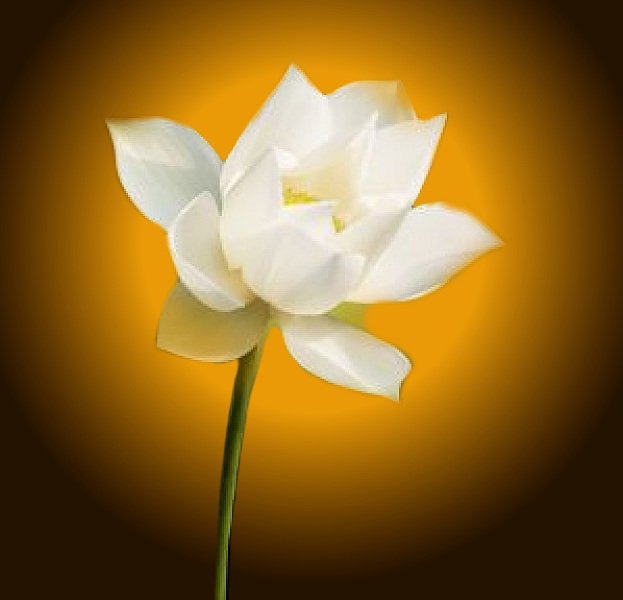
Prajnottara was an accomplished master who taught the Instantaneous Entrance to the Way, according to Mahayana Buddhism. In this approach, a master starts by preparing the disciple through many modes of training. When the disciple is finally ready, the master through individualized instructions points out the unborn and empty nature of everything. Having acquired the view of the space-like nature the disciple trains by resting in that view.
This lineage started when Buddha Sakyamuni showed a lotus flower in an assembly of disciples. In the assembly, it was only Mahakashyapa who realized the meaning behind this symbolic indication and a smile broke out on his face. Further the Buddha acknowledged Mahakashyapa’s realization. This lineage continued with Ananda, the Buddha’s close disciple, receiving the transmission from Mahakashyapa. Further the lineage passed on through many great masters such as Upagupta, Ashvaghosha, Nagarjuna, Aryadeva, Vasubandhu, etc. All of these masters were also great scholars and Siddhas and wrote many important treatises on the Mahayana philosophy and practice. Prajnottara was the 27th Master of this lineage.
When Bodhyottara’s father passed away, everyone was in mourning. Bodhyottara remained in meditation for seven days. After rising from meditation, he decided to dedicate his life to Dharma. He went to Prajnottara and requested to be accepted as his disciple. Prajnottara, realizing that the time was ripe, accepted him under his fold and imparted all the necessary teachings to him. Under the guidance of Prajnottara, Bodhyottara awakened to Bodhi. Then, Prajnottara gave him the name Bodhidharmottara (pronounced as Bodhidharmatara in Chinese sources), or in short Bodhidharma. He became the 28th Master in that unbroken lineage of realized masters.
Bodhidharma also mastered Medicine (Ayurveda, Siddha-medicine), Marma kala (similar to acupressure) and martial arts as part of his training. Buddhist Siddha tradition in South India has always been closely connected with healing and marma kala. For instance Nagarjuna and Aryadeva were also masters of Medicine.
The Silence of the Thunder
Prajnottara instructed Bodhidharma to go to China and impart the teachings of the Buddha there. Accordingly, Bodhidharma traveled to China by taking the sea route. By this time, Buddhism was already thriving well in China. Most of the Buddhist literature was already translated into Chinese. People had great faith and were pious. Many Buddhist masters from India used to visit China to teach and people there were eagerly looking forward to these visits. Many Chinese also used to visit India for pilgrimage and for deeper learning of Buddhism. It was into this China, a flourishing centre of Buddhism that Bodhidharma arrived.

Upon his arrival, Bodhidharma felt that people were getting lost in the conventionalities around Buddhism without getting into the essence of it. For example, though people were highly fascinated about making a lot of merit through virtuous deeds such as generosity, building temples and stupas, chanting , etc., they missed to look into their own minds and tame it. By losing this crux, even great merit making activities turned into just worldly dharma. Perhaps for this reason Bodhidharma strongly emphasized in his teachings there, the sudden realization method of settling into the nature of one’s own mind. Many of the anecdotes on Bodhidharma are narrations about how he shocked his disciples to break them away from their clinging to worldly dharma.
Immediately upon landing in China, he was invited to a monastery to deliver a teaching to a large number of people. Reaching the monastery, the Master went to the teaching dais and sat there in meditation. People waited and waited for his wisdom words and the typical ceremonies of a monastic assembly. But the Master just remained there silent like an unmoving mountain. Hours passed by and the air of silence was occasionally broken only when the perplexed whispers of people rose up like that of buzzing bees and settling again into a dense silence of anticipation. The Master remained undisturbed by the whispering winds of people’s expectations.
Then one moment, the Master just silently go up and simply walked away. Some wondered whether he was crazy, while some others speculated that there is some mystical meaning behind his silence. Whichever is the case, he succeeded in shocking them. At least a few would have settled and tasted the empty and brilliant expanse of mind in resonance with the Master’s intent, while others remained perplexed. And that was the beginning of Bodhidharma’s revolutionary journey through China.
After this, Bodhidharma went on to have his famous encounter with Emperor Wu as portrayed earlier.
The General who Carried His Mind into Monk-hood
After taking leave of Emperor Wu, Bodhidharma went northwards and reached the shores of the Yangtse River. There he came across a pavilion where a large crowd had gathered to hear the teaching of a famous Buddhist monk Shen Guang. Bodhidharma also joined the crowd to hear the lecture. Shen Guang also noticed the Indian monk, Bodhidharma, standing in the crowd. For some statements of Shen Guang, Bodhidharma nodded as if in agreement and for some others he nodded as if in disagreement.
When this continued for a while, Shen Guang started getting irritated. After some time, having lost patience, he took his mala (rosary) of heavy beads and flung hard at Bodhidharma’s face. In the force of the strike, two of the Master’s teeth fell down and he started bleeding. Shen Guang was taken aback as he didn’t expect to go that far. Bodhidharma just smiled and walked away peacefully., as if nothing happened. This intrigued Shen Guang. He thought that any normal man would immediately react instead of just walking away.
Shen Guang became quite restless. Curiosity bubbles up in him, and he rushes behind Bodhidharma. By the time he arrives at the banks of the Yangtse River, he sees Bodhidharma gently sailing northwards by standing on a single reed that floated on the river. He seems to glide through water as effortlessly like a swan. And, there is an old lady sitting with a bundle of reeds on the bank. Seeing this, Shen Guang follows by quickly grabbing a pair of reeds from her, throwing them on the river and then pushing himself over them. Obviously, the reeds couldn’t take his weight and he began to drown. At this time, the old lady took pity on him and pulled him out.

She exclaimed that the man who sails magnificently on that single reed must be a master of great accomplishment. She also told Shen Guang that the Master didn’t grab the reeds, but politely requested her for the same. In contrast, this teacher of many words came rushing with an agitated mind, and grabbed the reeds without even asking for permission. In fact, Bodhidharma could easily sail on a single reed by virtue of his mindfulness and his control over inner winds.
Since Shen Guang’s mind was already overtaken by aggression and bewilderment, he was deluded to take the effortless sail of Bodhidharma as a cakewalk. Mindlessly, he too pushed himself into the river on a pair of reeds without bothering about what it takes to sail on a reed. Then, he saw how easily he got agitated. He was carrying his agitation all the way from the pavilion till the point of getting drowned. That too, while he was trying to imbibe the teachings of peace and awakening in others as a Buddhist teacher! Shen Guang was a General in the army before ordaining as a monk. He was still carrying the aggression from his military past. Now, a hunch arose in him that the Master was in fact compassionately pointing out his fault. Then there was a deep yearning for meeting the Master and becoming his disciple. He too embarked upon a journey northwards following the Master.
The Shaolin Accounts
After crossing the Yangtse River, Bodhidharma journeyed to Shaolin Monastery. Shaolin had already seen some Indian masters before Bodhidharma. Even its first abbot was a master from India with the name Buddhabhadra,. The monks from Shaolin Monastery rejoiced upon Master Bodhidharma’s arrival and they warmly welcomed him to the monastery and requested for teaching. But Bodhidharma kept silence and walked up straight to a cave on the hills behind the monastery. He settled down in meditation posture facing a wall in that cave. The ex-General Shen Guang who followed the Master, too waited around the cave pleading for teaching.
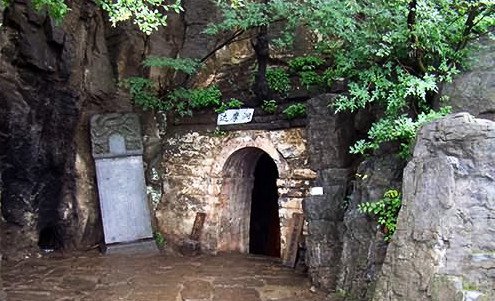
Seasons passed by. The hill was covered by white snow in winter. The Shaolin monks requested the Master many times to come down to the monastery and be comfortable there. But, Bodhidharma simply remained silent in unmoving meditation. It is said that because of the power of his meditation, his body print got etched in to the wall of the cave. Nine years passed by. Meanwhile Shen Guang kept on requesting for instructions. The locals and monks often visited and venerated the towering yet calming presence of the Master in deep meditation. Yet, the Master remained silent in the Samadhi of the profound view. Time was not yet ripe to turn the wheel of Dharma. He must have felt that nobody is ready yet to receive his teachings effectively.
Then, it was yet another severe winter. And, Shen Guang was waiting in the snow, day and night. He felt like his merit is not enough to receive the precious teachings from the great Master. Out of desperation he started crying and even his tears were freezing. Images of the great sacrifices made by Bodhisattvas of the past flashed through his mind. Then, he took a sword and chopped off his own hand and swirled it around in the air as an act of supreme offering. The snow turned red, and that was his last act of aggression.
Even though he had noticed his aggression way back on the banks of the Yangtse River, his pursuit for instructions from the Master was also aggressive in nature. He was being aggressive to tame his aggression. It was of the tone, “I, the great monk of many words is the one to now follow and receive pith instructions from the great Master”. In his final act of aggression he not only chopped off his arm, but more importantly he chopped off his ego and was ready to receive the teaching.
Then, Bodhidharma calmly came out of the cave and accepted Shen Guang as his disciple.
Shen Guang beseeched the Master, “My mind has no peace as yet! I beg you, O Master, please put it to rest!”
Bodhidharma said, “Bring your mind here and I will pacify it”
Shen Guang searched for a while and responded, “I have searched for my mind, and I cannot take hold of it.”
Bodhidharma exclaimed, “Now your mind is pacified.”
That is how Shen Guang awakened to the empty and peaceful nature of his own mind. This conversation became another famous Koan in Zen/ Chan.
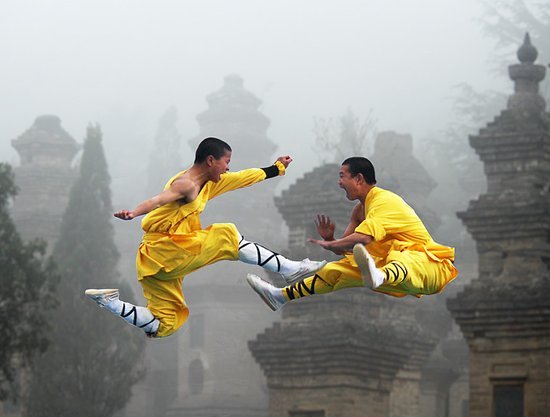
Bodhidharma then proceeded to the Shaolin Temple and taught there for his remaining years. He bestowed the name Huike to Shen Guang.(Hui-k’o-he means who is capable of wisdom) Huike later became the 29th lineage Master of the Zen/Chan tradition. The other main disciples of Bodhidharma were Dao-fu, Dao-yu, and the nun Zong Chi(Tsung-ch’ih).
Bodhidharma is depicted in the Chinese paintings as wild haired, dark skinned and wide eyed, sporting a beard, with big round earrings and a fierce look. Although the Chinese legends portray him as a Buddhist monk, from his looks he could as well have been a Buddhist mendicant Yogi.
We shall come back to the details of his teachings in the second and third parts of this trilogy.
Leaving a Footprint in China

Bodhidharma ’s last days were in China and he was buried there. There is an interesting account in China associated with his passing away. Years after Bodhidharma’s passing away, a Chinese diplomat was traveling in Pamir Mountains. He was away from China for a long time and was not aware of the Master’s passing away. In Pamir Mountains he saw the Master walking barefoot holding a shoe. The diplomat paid homage r the Master and the Master told him that he was returning to India.
As the diplomat arrived in China, he was shocked to know that Bodhidharma had already passed away. He went to the emperor and narrated his encounter with Bodhidharma. At first, people thought that he was crazy. However, since he was well known to the emperor, the burial chamber was thereby opened and it was found to be empty except for one shoe! Bodhidharma being a highly realized master, it is possible that his corporeal body dissolved into the luminosity of awareness, like some of the other great masters of the Buddhist Siddha lineage.
The single shoe he left behind is probably indicative of the foot print of his teachings that the Master left in China.
View the Complete Trilogy at
Bodhidharma – a Trilogy on His Life and Teachings
Authors – Yogini Abhaya Devi & Yogi Prabodha Jnana
- Like a bird flying through the vast expanse - September 21, 2021
- The Liberation Story of Punnika, a Girl from an Oppressed Caste - March 31, 2021
- Ancient Buddha Statues of Kerala - October 11, 2018


